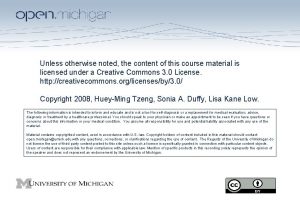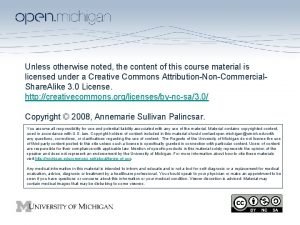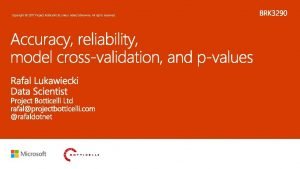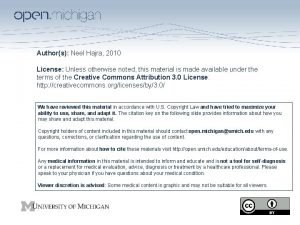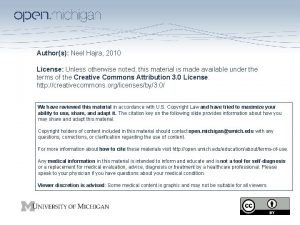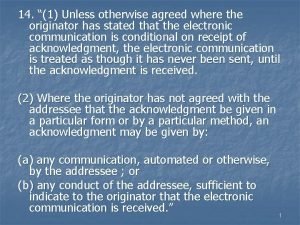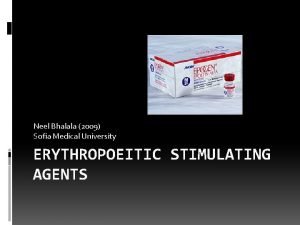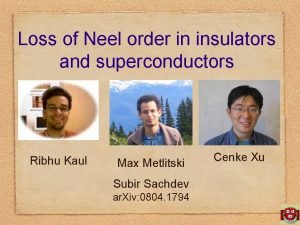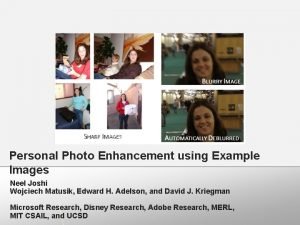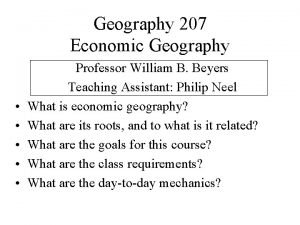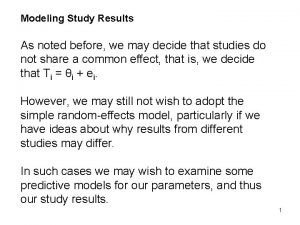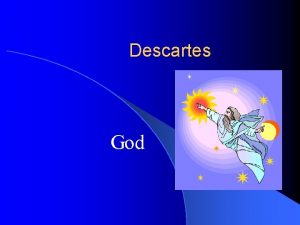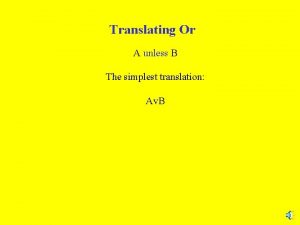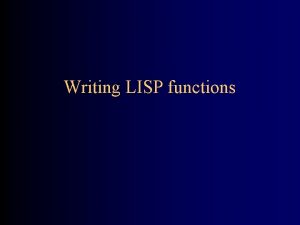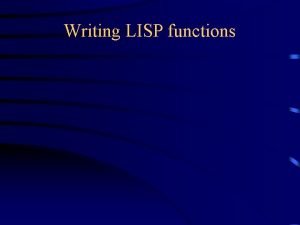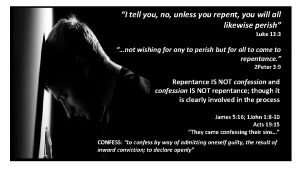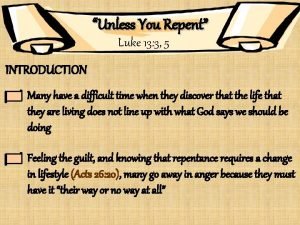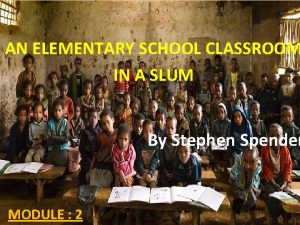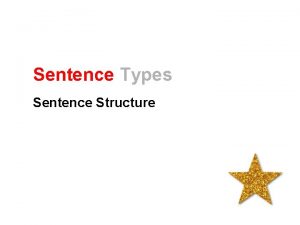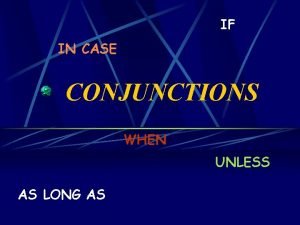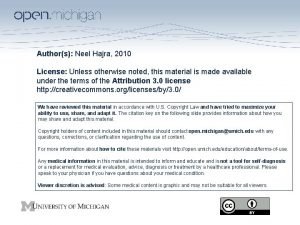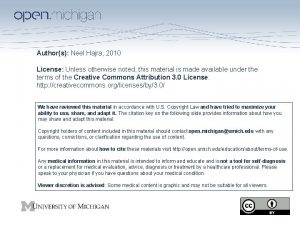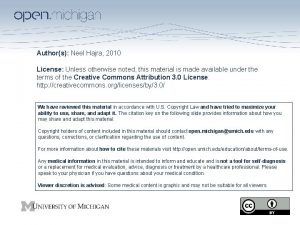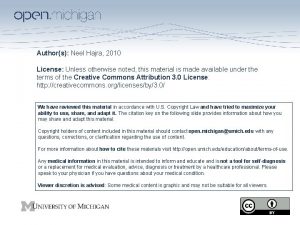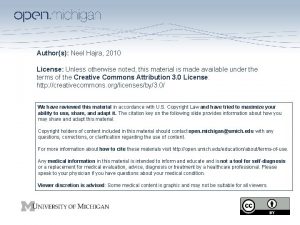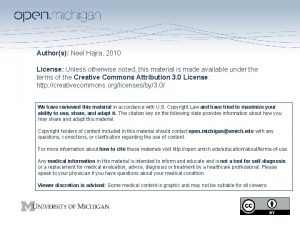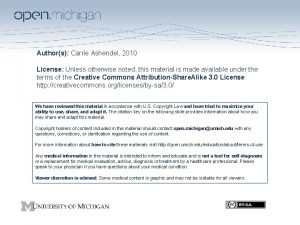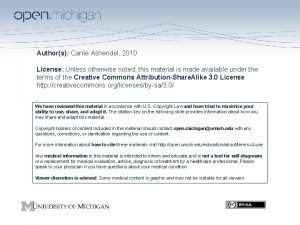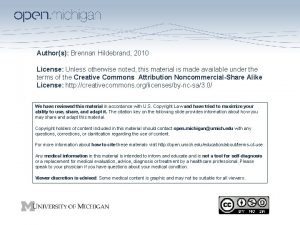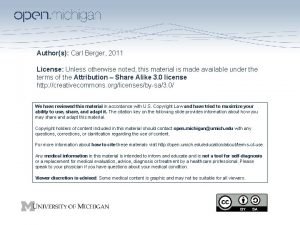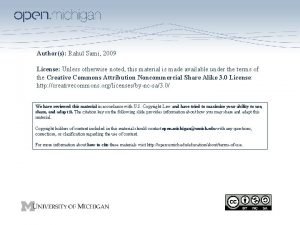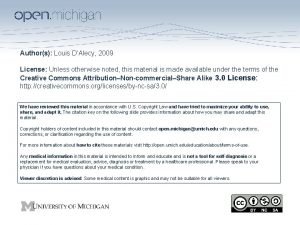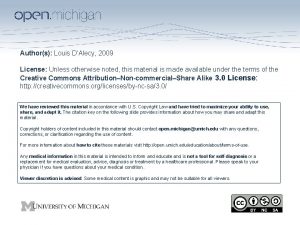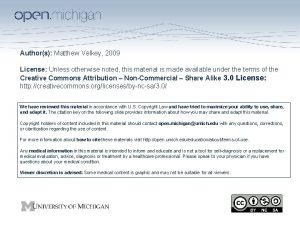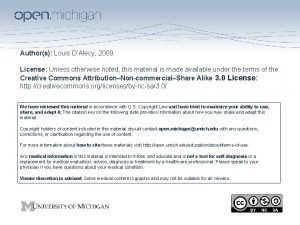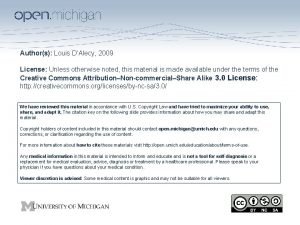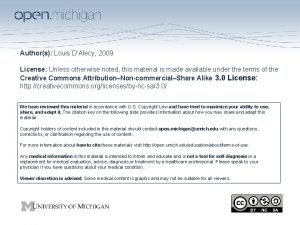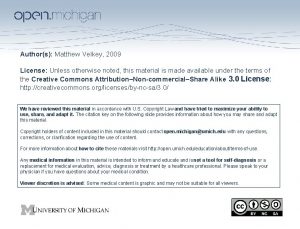Authors Neel Hajra 2010 License Unless otherwise noted






























- Slides: 30

Author(s): Neel Hajra, 2010 License: Unless otherwise noted, this material is made available under the terms of the Creative Commons Attribution 3. 0 License: http: //creativecommons. org/licenses/by/3. 0/ We have reviewed this material in accordance with U. S. Copyright Law and have tried to maximize your ability to use, share, and adapt it. The citation key on the following slide provides information about how you may share and adapt this material. Copyright holders of content included in this material should contact open. michigan@umich. edu with any questions, corrections, or clarification regarding the use of content. For more information about how to cite these materials visit http: //open. umich. edu/education/about/terms-of-use. Any medical information in this material is intended to inform and educate and is not a tool for self-diagnosis or a replacement for medical evaluation, advice, diagnosis or treatment by a healthcare professional. Please speak to your physician if you have questions about your medical condition. Viewer discretion is advised: Some medical content is graphic and may not be suitable for all viewers.

Citation Key for more information see: http: //open. umich. edu/wiki/Citation. Policy Use + Share + Adapt { Content the copyright holder, author, or law permits you to use, share and adapt. } Public Domain – Government: Works that are produced by the U. S. Government. (USC 17 § 105) Public Domain – Expired: Works that are no longer protected due to an expired copyright term. Public Domain – Self Dedicated: Works that a copyright holder has dedicated to the public domain. Creative Commons – Zero Waiver Creative Commons – Attribution License Creative Commons – Attribution Share Alike License Creative Commons – Attribution Noncommercial Share Alike License GNU – Free Documentation License Make Your Own Assessment { Content Open. Michigan believes can be used, shared, and adapted because it is ineligible for copyright. } Public Domain – Ineligible: Works that are ineligible for copyright protection in the U. S. (USC 17 § 102(b)) *laws in your jurisdiction may differ { Content Open. Michigan has used under a Fair Use determination. } Fair Use: Use of works that is determined to be Fair consistent with the U. S. Copyright Act. (USC 17 § 107) *laws in your jurisdiction may differ Our determination DOES NOT mean that all uses of this 3 rd-party content are Fair Uses and we DO NOT guarantee that your use of the content is Fair. To use this content you should do your own independent analysis to determine whether or not your use will be Fair.

Pub. Pol 671: Policy & Management in the Nonprofit Sector Lecture 5: Mission & Management Neel Hajra

Legal Framework Continued Federal, state, and local regulation of nonprofits Articles of Incorporation, Bylaws IRS Tax exemption (public support test, etc. ) Patchwork of regulation yields relatively laissez faire enforcement

Note – 501(c)(4) May: ◦ Lobby without restriction ◦ Endorse candidates (previously to membership, now arguably to anyone) May not: ◦ Contribute to or coordinate with candidates ◦ Primarily engage in electoral activity

Internal Revenue Service IRS enforces at federal level Enforcement options: ◦ “Intermediate sanctions” ◦ Revocation of 501(c)(3) status (often used as negotiating tool)

Next: Local

Property Tax Exemptions Increasingly contentious “Payments in lieu of taxes” Recall University examples: Pittsburgh effort is a new frontline in the “town vs. gown” property tax battles

Next: Common Law

Organizational Enforcement Judicial case law Varies significantly by jurisdiction Reflects nature of U. S. legal system

Individual Liability Balancing the rights of harmed vs. viability of sector D&O liability and insurance Volunteer liability and insurance

Cy Pres Doctrine Departing as minimally as possible from charitable intentions that are impossible or unlawful (or sometimes wasteful!) to carry out

Patchwork Enforcement Federal: IRS State: Attorney General Local: Taxing authorities General: Court systems Result: LAX ENFORCEMENT, generally laissez faire

Next… Our first foray into management topics!! Primacy and function of mission Impact of mission on management The double bottom line

Function of Mission

Definition of “Mission” “Why we do what we do, ” a reason for being, a purpose (Dees) “What we are producing and for whom, ” a reflection of core values (Oster)

Boundary Functions Activity Boundary: ◦ Defines scope, for-profits measure by profits while nonprofits need this boundary more Ideology Boundary: ◦ Nonprofit often have ideological origins – not just a strict response to a need Theoretical/Relational Boundary: ◦ Supports market failure theory (trust & reputation)

Motivation Functions Clear mission attracts ideological allies. Mission invites broader participation by staff, donors, consumers, and volunteers

Operational Functions Alignment: A “lever” that allows for shared responsibility and accountability Resources: Joins people and money Strategy: Shapes strategic direction Evaluation: Defines “success” Guide: Mission should serve as cornerstone of ongoing decisionmaking

Broad vs. Narrow Mission Broad Easier to pursue new opportunities and evolve Easier to appeal to a broader donor base Narrow Easier to attract ideological allies Easier to minimize mission creep and maintain focus Easier to evaluate

Impact of Mission on Management

Mission Attracts a Variety of Stakeholders Board Staff Volunteers Customers Donors Partner agencies

Mission Can Slow Decisions Open/Debated Consensus Command Control Management Style Mission-Based E. g. , NEW’s previous planning process “Open and debated” (Dees) can definitely go too far! Neel Hajra

Mission Creep Chasing the money ◦ Contributions ◦ Earned Income Entrepreneurialism Broad stakeholder base Changing “mission market”

Creep Can Be Complex… Other nonprofits Services Volunteers Staff Donors MISSION Board Customers Legal/ Regulatory Public Sentiment For-profit sector Public sector Neel Hajra (E. g. , new service ideas)

Human Resources Compensation: ◦ Maybe Mission enhances efficiency? Volunteers: ◦ Efficiencies vs. Costs Hiring: ◦ Is someone ‘on the bus’? Firing: ◦ Harder to do

Evaluation Performance Measurement can be tough, and expensive Subject of next two classes

Transparency Public “owns” mission Transparency is a self-regulatory mechanism Managing scrutiny can be challenging Transparency can be counter to “running like a business” (e. g. : intellectual property/know-how, salaries, strategies, donors)

Frames of Reference A nonprofit answers to many groups Each group interprets mission in slightly different manner Implications ◦ Amorphous targets ◦ Difficult to create uniform standards

Class Activity: Write a Mission! Your group came together to encourage art instruction and appreciation among local youth. You need a mission statement (and a name) CONSIDER: • What? • Why? • How? • Focus? • Clarity? • Breadth? • Inspirational?
 Huey-ming tzeng
Huey-ming tzeng Unless otherwise noted meaning
Unless otherwise noted meaning Unless noted otherwise
Unless noted otherwise Excecro
Excecro Neel hajra
Neel hajra Unless otherwise agreed
Unless otherwise agreed Robert neel md
Robert neel md Neel order
Neel order Difference between curie temperature and neel temperature
Difference between curie temperature and neel temperature Neel bhalala
Neel bhalala Difference between curie temperature and neel temperature
Difference between curie temperature and neel temperature Difference between antiferromagnetism and ferrimagnetism
Difference between antiferromagnetism and ferrimagnetism Mst
Mst Neel sachdev
Neel sachdev Benjamin burnham sea of poppies
Benjamin burnham sea of poppies Neel joshi microsoft
Neel joshi microsoft Philip neel
Philip neel Cristen chin model
Cristen chin model Noted
Noted Factitious ideas examples
Factitious ideas examples A unless b
A unless b Lisp cond
Lisp cond Lisp unless
Lisp unless Jeopardy romeo and juliet
Jeopardy romeo and juliet Unless you repent you will all likewise perish
Unless you repent you will all likewise perish Unless you repent
Unless you repent The elementary school classroom in a slum poetic devices
The elementary school classroom in a slum poetic devices Sentences that start with unless
Sentences that start with unless Unless oraciones
Unless oraciones Unless
Unless In case unless
In case unless
